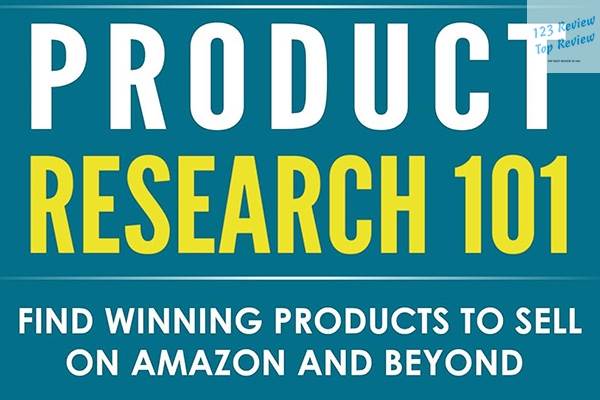Written by industry expert Renae Clark, In this article, 123 Review breaks down the key steps and strategies involved in researching new products, from understanding market trends to analyzing customer needs. Whether you’re an entrepreneur, marketer, or product manager, this guide provides practical tips and tools to help you make informed decisions and stay ahead of the competition. Perfect for beginners and seasoned professionals alike, “Product Research 101” is your go-to resource for navigating the complexities of product development.
Understanding the Importance of Product Research
In the ever-evolving world of e-commerce, where competition is fierce and consumer preferences are constantly shifting, the importance of thorough product research cannot be overstated. Whether you’re launching your first online store or are an experienced seller looking to expand your product line, the success of your business hinges on your ability to select products that resonate with your target audience and offer a healthy profit margin.

Renae Clark, a seasoned e-commerce expert with years of experience in helping entrepreneurs build successful online businesses, emphasizes that product research is not merely a preliminary step—it’s the foundation upon which your entire business strategy should be built. By investing time and resources into comprehensive product research, you can avoid common pitfalls, identify lucrative opportunities, and position your business for long-term success.
Factors Influencing Product Selection
The process of selecting the right products for your e-commerce store involves considering a multitude of factors, each of which can significantly impact your business’s success. Understanding these factors is crucial to making informed decisions that align with your business goals and market demands.
- Market Demand: At the core of product selection is the concept of market demand. This refers to the level of interest or desire for a particular product within your target market. Products with high demand are more likely to sell quickly and consistently, making them attractive choices for e-commerce businesses. To assess market demand, you can use tools like Google Trends, keyword research tools, and sales data from platforms like Amazon. It’s essential to select products that not only have current demand but also show potential for sustained interest over time.
- Profit Margins: Profitability is a key consideration when selecting products. After all, the goal of any business is to generate a profit. When evaluating potential products, calculate the profit margins by subtracting all costs—including manufacturing, shipping, and marketing—from the selling price. It’s important to ensure that the products you choose offer a margin that justifies your investment of time, money, and effort. Products with slim margins may not be worth pursuing, especially if they require significant resources to market and sell.
- Competition: The level of competition in a product category can greatly influence your success. Entering a highly competitive market with established players can be challenging, especially if you lack a unique selling proposition (USP). However, this doesn’t mean that you should avoid competitive markets altogether. Instead, focus on identifying niches within broader markets where competition is less intense. By offering a unique product or targeting a specific audience segment, you can carve out a profitable space for your business.
- Customer Pain Points: Understanding and addressing customer pain points is a powerful way to select products that will resonate with your audience. Products that solve specific problems or fulfill unmet needs are more likely to be successful. To identify these pain points, consider conducting customer surveys, analyzing reviews of existing products, and participating in online forums and social media groups related to your niche. By aligning your product offerings with the needs and desires of your target audience, you can increase your chances of success.
The Role of Market Trends in Product Research
Market trends are a dynamic and influential factor in product research, guiding businesses toward products that are likely to gain popularity in the near future. Staying informed about emerging trends allows you to capitalize on new opportunities before they become saturated, giving you a competitive edge in the market.
Renae Clark advocates for a proactive approach to monitoring market trends. This involves regularly reviewing a variety of sources, including industry reports, social media platforms, and trend-tracking tools like Google Trends. By keeping your finger on the pulse of consumer behavior and preferences, you can identify patterns that indicate a shift in demand. For example, the growing trend toward sustainability has led to increased demand for eco-friendly products, creating opportunities for businesses to cater to environmentally conscious consumers.
However, it’s important to approach trends with a critical eye. Not all trends are worth pursuing, and some may be short-lived fads rather than long-term shifts. Before committing to a trend-based product, conduct thorough research to assess its potential longevity and relevance to your target audience. Additionally, consider how the trend aligns with your brand identity and overall business strategy.
Assessing Competition in Product Categories
A comprehensive analysis of the competitive landscape is essential for successful product research. Understanding who your competitors are, what they offer, and how they market their products will provide valuable insights that can inform your product selection and marketing strategies.
To assess competition, start by identifying the main players in your chosen product category. This includes both direct competitors (those offering similar products) and indirect competitors (those offering alternatives or substitutes). Tools like Jungle Scout, AMZScout, and Helium 10 can help you gather data on competitors’ sales volumes, pricing strategies, and customer reviews. By analyzing this information, you can identify gaps in the market that your business can fill.
One effective strategy for dealing with competition is differentiation. This involves creating a unique selling proposition (USP) that sets your products apart from those of your competitors. Differentiation can be achieved through various means, such as offering superior quality, unique features, exceptional customer service, or a compelling brand story. By differentiating your products, you can attract customers who are looking for something distinct from what is currently available in the market.
Steps to Find Winning Products
Finding winning products—the kind that consistently sell well and generate a profit—requires a systematic and methodical approach. By following a structured process, you can increase your chances of selecting products that will perform well in the market and contribute to the success of your business.
Basic Steps for Product Research
- Identify a Niche: The first step in product research is to identify a specific niche within the broader market. A niche is a specialized segment of the market that caters to a particular group of customers with specific needs or preferences. Choosing a niche with strong demand and manageable competition is crucial for success. To identify a profitable niche, consider your own interests and expertise, as well as market demand and competition levels. Tools like Google Keyword Planner and niche-specific forums can help you explore potential niches and assess their viability.
- Analyze Market Demand: Once you’ve identified a niche, the next step is to analyze market demand. This involves researching the level of interest in the products within your chosen niche. Use tools like Google Keyword Planner, Google Trends, and Amazon’s Best Sellers Rank (BSR) to gauge the popularity of relevant keywords and products. Look for products with consistent demand and search volume, as these are more likely to sell well over time.
- Evaluate Competition: Competition analysis is a critical step in product research. Evaluate the level of competition in your chosen niche by analyzing the top-selling products and brands. Look for gaps in the market where competition is lower, or identify opportunities to differentiate your products from those of your competitors. Consider factors such as product quality, pricing, customer reviews, and brand reputation when evaluating competition.
- Assess Profitability: Profitability is a key consideration when selecting products. Calculate the potential profit margins for each product by subtracting all costs—including manufacturing, shipping, marketing, and platform fees—from the expected selling price. Ensure that the products you choose offer a margin that justifies your investment. Low-margin products may not be worth pursuing, especially if they require significant resources to market and sell.
- Test Products: Before committing to a large inventory, consider testing your product ideas with a small batch. This allows you to gauge market response and make adjustments before scaling up. You can test products by listing them on platforms like Amazon, eBay, or your own e-commerce store. Monitor sales performance, customer feedback, and return rates to determine whether the product is a good fit for your business.
Techniques for Generating Product Ideas
Generating product ideas can be one of the most challenging aspects of product research. However, several techniques can help you identify promising products that align with your niche and business goals.
- Brainstorming: Start by brainstorming potential product ideas based on your interests, industry knowledge, and market research. Make a list of products that you find intriguing or that align with your target audience’s needs. Don’t be afraid to think outside the box and consider unconventional products that may have untapped potential.
- Competitor Analysis: Analyzing what your competitors are selling successfully can provide valuable insights into product opportunities. Look for patterns in their product offerings, such as recurring themes, popular features, or frequently updated listings. Identify products that are selling well and consider how you can offer a similar product with added value or differentiation.
- Customer Feedback: Customer feedback is a goldmine of information for generating product ideas. Pay attention to customer reviews, ratings, and comments on existing products in your niche. Look for common complaints, suggestions for improvement, or unmet needs that you can address with a new product. Additionally, consider conducting surveys or polls to gather direct feedback from your target audience.
- Social Media: Social media platforms like Instagram, Pinterest, and TikTok are excellent sources of inspiration for trending products. Follow influencers, industry leaders, and popular accounts in your niche to stay updated on the latest trends and product ideas. Social media can also provide insights into consumer behavior, preferences, and pain points, which can inform your product research.
Analyzing Sales Data for Product Validation
Validating your product ideas with sales data is a crucial step before making significant investments in inventory or marketing. Sales data provides objective insights into how similar products are performing in the market, helping you make informed decisions about which products to pursue.
To analyze sales data, use tools like Helium 10, Jungle Scout, and AMZScout, which offer detailed information on product sales volumes, historical trends, pricing fluctuations, and seasonality. These tools allow you to track the performance of products over time, identify patterns, and forecast potential sales for your chosen products.
When analyzing sales data, pay attention to factors such as:
- Sales Velocity: The rate at which products are selling. High sales velocity indicates strong demand, while low sales velocity may suggest limited interest.
- Pricing Trends: Fluctuations in product pricing over time. Understanding pricing trends can help you set competitive prices and maximize profit margins.
- Seasonality: Some products experience seasonal demand, with sales peaking during certain times of the year. Consider how seasonality may impact your sales and inventory planning.
By thoroughly analyzing sales data, you can validate your product ideas and make informed decisions about which products to add to your inventory.
Tools and Resources for Product Research
In today’s digital age, a wide range of online tools and resources are available to assist you in conducting thorough and efficient product research. These tools can streamline the research process, provide valuable data insights, and help you make informed decisions about which products to pursue.
Key Online Tools for Finding Products
Several online tools are specifically designed to help e-commerce sellers find and evaluate products. These tools offer a variety of features, including keyword research, sales data analysis, and competitor tracking. Here are some of the most popular and effective tools for product research:
- Jungle Scout: Jungle Scout is a comprehensive tool designed for Amazon sellers. It offers a suite of features, including product research, keyword research, sales tracking, and competitor analysis. Jungle Scout’s Product Database allows you to search for products based on specific criteria, such as category, price range, and sales volume. The tool also provides insights into product trends, historical sales data, and profit margins, making it a valuable resource for finding winning products.
- Helium 10: Helium 10 is another powerful tool for Amazon sellers, offering a wide range of features for product research, listing optimization, and sales tracking. Helium 10’s Black Box tool allows you to search for products based on various filters, such as niche, price, and competition level. The tool also provides detailed sales data, keyword research, and market trends, helping you validate your product ideas and optimize your listings for maximum visibility.
- Oberlo: Oberlo is a popular tool for dropshipping businesses, allowing you to find and import products from suppliers directly into your online store. Oberlo’s Product Search feature enables you to browse a wide range of products, filter results by category and price, and view sales trends and supplier ratings. The tool also offers insights into shipping times, profit margins, and product reviews, making it easier to select reliable products for your store.
- AMZScout: AMZScout is a versatile tool that offers features for product research, keyword analysis, and competitor tracking. The tool’s Product Database allows you to search for products based on specific criteria, such as category, price, and sales volume. AMZScout also provides insights into product trends, historical sales data, and market demand, helping you make informed decisions about which products to pursue.
Utilizing Social Media and Forums for Trends
In addition to dedicated product research tools, social media platforms and online forums are valuable resources for staying informed about emerging trends and consumer preferences. By actively participating in these platforms, you can gain insights into what products are gaining popularity, what consumers are looking for, and how you can position your products to meet those demands.
- Social Media: Platforms like Instagram, Pinterest, and TikTok are powerful tools for trend discovery and product inspiration. Follow influencers, industry leaders, and popular accounts in your niche to stay updated on the latest trends and product ideas. Social media can also provide insights into consumer behavior, preferences, and pain points, which can inform your product research. Use hashtags, explore popular posts, and engage with your audience to gather real-time feedback and ideas.
- Online Forums: Online forums like Reddit, Quora, and niche-specific communities are valuable sources of information for product research. Participate in discussions, ask questions, and read through threads to understand what topics are trending and what products are being talked about. Forums can provide insights into consumer needs, pain points, and product preferences, helping you identify opportunities for new products or improvements to existing ones.
- Facebook Groups: Facebook Groups are another excellent resource for trend discovery and product research. Join groups related to your niche or industry, and actively participate in discussions. Pay attention to common questions, complaints, and product recommendations shared by group members. Facebook Groups can provide valuable insights into consumer behavior and preferences, helping you stay ahead of the curve in your product research.
Importance of Supplier Directories in Sourcing
Supplier directories are invaluable resources for finding reliable manufacturers and wholesalers for your products. These directories provide access to a wide range of suppliers from around the world, offering products at competitive prices and varying levels of quality. By using supplier directories, you can streamline the sourcing process and ensure that you are working with reputable suppliers who meet your quality and pricing standards.
- Alibaba: Alibaba is one of the largest and most popular supplier directories in the world, connecting businesses with manufacturers and wholesalers primarily based in China. Alibaba offers a vast selection of products across various categories, making it easy to find suppliers for almost any product. The platform also provides detailed supplier profiles, including ratings, reviews, and certifications, helping you verify the credibility and reliability of potential suppliers. When sourcing products from Alibaba, it’s essential to communicate clearly with suppliers, request samples, and negotiate terms to ensure a successful partnership.
- Global Sources: Global Sources is another major supplier directory that connects businesses with manufacturers and wholesalers, primarily in Asia. The platform offers a wide range of products and features detailed supplier profiles, including company information, product certifications, and customer reviews. Global Sources also hosts trade shows and online exhibitions, providing opportunities for businesses to connect with suppliers in person or virtually. When using Global Sources, it’s important to thoroughly vet suppliers, request samples, and establish clear communication channels to ensure a smooth sourcing process.
- ThomasNet: ThomasNet is a supplier directory focused on connecting businesses with manufacturers and suppliers in North America. The platform offers a wide range of products, including industrial and commercial goods, making it a valuable resource for businesses looking to source domestically. ThomasNet provides detailed supplier profiles, including company information, product certifications, and customer reviews, helping you find reliable suppliers who meet your quality and pricing standards. Sourcing from domestic suppliers can offer advantages such as faster shipping times, easier communication, and reduced import duties, making it an attractive option for certain businesses.
Validating Product Demand
Validating product demand is a crucial step in the product research process, ensuring that the products you choose to sell have a strong likelihood of success in the market. Without proper demand validation, you risk investing time and resources into products that may not sell, leading to unsold inventory and financial losses.
Techniques for Demand Validation
Several techniques can help you validate product demand and ensure that the products you choose have a strong likelihood of success in the market.
- Keyword Research: Keyword research is a powerful tool for assessing demand by analyzing search volume for product-related keywords. Use tools like Google Keyword Planner, Ahrefs, and SEMrush to identify keywords related to your products and analyze their search volume. High search volume indicates strong interest in the product, while low search volume may suggest limited demand. Additionally, consider the competition level for each keyword, as highly competitive keywords may be more challenging to rank for in search results.
- Social Listening: Social listening involves monitoring social media platforms for mentions of products, brands, or related keywords. Use tools like Brand24, Mention, and Hootsuite to track social media activity and gather insights into consumer sentiment, preferences, and pain points. Social listening can provide valuable real-time feedback on product demand, helping you identify trends and gauge interest in your products before launching.
- Pre-Orders: Offering products on a pre-order basis is an effective way to gauge interest and demand before committing to large inventory purchases. Pre-orders allow customers to reserve a product before it is officially released, providing you with valuable data on potential sales. If a product receives a significant number of pre-orders, it’s a strong indicator of demand and can justify a larger inventory investment. Additionally, pre-orders can help you generate revenue upfront, reducing the financial risk associated with product launches.
How to Check Product Ranking on Amazon
Amazon’s Best Sellers Rank (BSR) is a valuable metric for understanding product demand and popularity within specific categories. The BSR reflects the sales performance of a product relative to others in its category, with a lower BSR indicating higher sales.
To check product ranking on Amazon, start by searching for similar products within your chosen category. Review the BSR for each product, paying close attention to the top-ranked items. Tools like Jungle Scout and AMZScout can automate this process, providing real-time data on product rankings, sales estimates, and historical trends.
When analyzing BSR data, consider the following factors:
- Sales Velocity: Products with a consistently low BSR are likely to have high sales velocity, indicating strong demand.
- Category Size: Larger categories with more products may have a wider range of BSR values, making it important to compare rankings within the same category.
- Product Variations: If a product has multiple variations (e.g., sizes, colors), consider how each variation ranks relative to the others.
By analyzing BSR data, you can estimate how well a product is likely to perform and make informed decisions about which products to add to your inventory.
Assessing Customer Search Volume
Understanding customer search volume is critical for predicting demand and ensuring that your products are likely to attract traffic and generate sales. Search volume data provides insights into how many potential customers are searching for products in your niche, helping you identify opportunities and make informed decisions about product selection.
To assess customer search volume, use tools like Ahrefs, SEMrush, and Google Keyword Planner to analyze search volume for specific keywords related to your products. Look for keywords with high search volume and low to moderate competition, as these often indicate strong demand with less direct competition.
Additionally, consider the intent behind customer searches. Keywords with strong buying intent, such as “buy,” “best,” or “reviews,” suggest that customers are actively seeking products and are more likely to convert into sales. By focusing on high-intent keywords with substantial search volume, you can increase your chances of selecting products that will perform well in the market.
Tips for Sourcing Products Effectively
Sourcing products effectively is a critical component of building a successful e-commerce business. Finding reliable suppliers, negotiating favorable terms, and ensuring product quality are all essential steps in the sourcing process. By following best practices for sourcing, you can secure high-quality products at competitive prices, ensuring a smooth and profitable operation.
Finding Reliable Suppliers
One of the most important aspects of product sourcing is finding reliable suppliers who can consistently deliver high-quality products on time. Establishing strong relationships with trustworthy suppliers is crucial for maintaining inventory levels, meeting customer expectations, and avoiding costly delays or quality issues.
- Research and Vetting: Start by researching potential suppliers using supplier directories like Alibaba, Global Sources, and ThomasNet. Review supplier profiles, including ratings, reviews, certifications, and product samples. Look for suppliers with a proven track record of reliability, quality, and customer satisfaction. Request samples from multiple suppliers to compare product quality and assess their ability to meet your specifications.
- Communication: Clear and consistent communication is key to building strong relationships with suppliers. Establish open lines of communication from the outset, discussing product specifications, pricing, lead times, and payment terms in detail. Ensure that the supplier understands your requirements and is willing to work with you to address any issues that may arise. Regular communication can help prevent misunderstandings and ensure that both parties are aligned on expectations.
- Negotiation: Negotiating favorable terms with suppliers is an essential part of the sourcing process. Be prepared to discuss pricing, minimum order quantities, lead times, and payment terms with potential suppliers. Keep in mind that while price is important, it should not be the sole deciding factor. Consider factors such as product quality, reliability, and supplier reputation when making your final decision. In some cases, it may be worth paying a slightly higher price for a supplier who can offer better quality or faster delivery times.
Domestic vs. Overseas Sourcing Considerations
When sourcing products, one of the key decisions you’ll need to make is whether to source domestically or overseas. Each option has its own set of advantages and challenges, and the right choice will depend on your business’s specific needs, budget, and target market.
- Domestic Sourcing: Sourcing products from domestic suppliers offers several advantages, including faster shipping times, easier communication, and reduced import duties. Domestic suppliers are often more responsive to custom orders and can provide greater flexibility in terms of order quantities and lead times. Additionally, sourcing domestically may be more appealing to customers who prefer products made in their home country. However, domestic products may come with higher production costs, which can impact profit margins.
- Overseas Sourcing: Overseas sourcing, particularly from countries like China, offers the potential for lower production costs, which can result in higher profit margins. Overseas suppliers often have access to a wider range of products and materials, allowing for greater customization and variety. However, overseas sourcing comes with challenges, including longer shipping times, language barriers, and potential quality control issues. Additionally, navigating import regulations, tariffs, and customs can add complexity to the process.
When deciding between domestic and overseas sourcing, consider factors such as cost, quality, lead times, and customer preferences. Weigh the pros and cons of each option to determine the best sourcing strategy for your business.
Evaluating Margin Profit and Pricing Strategies
Maximizing profit margins is a key goal for any e-commerce business. To achieve this, it’s essential to carefully evaluate your cost structure and pricing strategies. By optimizing your margins and setting competitive prices, you can increase profitability while remaining attractive to customers.
- Cost Analysis: Start by conducting a thorough analysis of all costs associated with your products, including manufacturing, shipping, packaging, marketing, and platform fees. Understanding your total cost per unit will allow you to set prices that cover your expenses while generating a healthy profit margin. Be sure to account for any hidden costs, such as returns, refunds, and storage fees, that could impact your bottom line.
- Pricing Strategies: Once you have a clear understanding of your costs, you can develop a pricing strategy that aligns with your business goals. Common pricing strategies include:
- Cost-Plus Pricing: This involves adding a fixed percentage markup to your cost per unit to determine your selling price. This straightforward approach ensures that all costs are covered and allows for consistent profit margins.
- Competitive Pricing: With this strategy, you set your prices based on what your competitors are charging for similar products. While this approach can help you remain competitive in the market, it’s important to ensure that your prices still allow for a reasonable profit margin.
- Value-Based Pricing: This strategy involves setting prices based on the perceived value of your product to the customer. If your product offers unique features or superior quality, you may be able to charge a premium price. Value-based pricing requires a deep understanding of your target audience and what they are willing to pay for your product.
- Margin Optimization: Regularly review and optimize your profit margins by identifying opportunities to reduce costs or increase prices. For example, you may be able to negotiate better terms with suppliers, reduce shipping costs by optimizing packaging, or raise prices in response to increased demand. By continuously monitoring your margins, you can ensure that your business remains profitable over the long term.
Case Studies and Examples
Learning from real-world examples and case studies can provide valuable insights into the product research process. By examining the successes and challenges faced by other e-commerce sellers, you can gain a deeper understanding of what works—and what doesn’t—in product research and selection.
Success Stories from Renae Clark’s Experience
Renae Clark has helped numerous entrepreneurs launch successful e-commerce businesses by guiding them through the product research process. Here are a few success stories that highlight the impact of thorough product research:
- Eco-Friendly Products: One of Renae’s clients, a new e-commerce entrepreneur, was passionate about sustainability and wanted to create a brand centered around eco-friendly products. Through detailed product research, they identified a growing trend in reusable kitchen products, such as silicone food storage bags and beeswax wraps. By carefully analyzing market demand, competition, and pricing, the client was able to source high-quality products and successfully launch their brand. Within the first year, the brand generated six-figure revenue, thanks to the strong demand for sustainable products and a well-executed marketing strategy.
- Niche Health Supplements: Another client sought Renae’s guidance in entering the health and wellness market, which is known for its high competition. Through extensive research, they identified a niche in plant-based supplements targeting specific health concerns, such as digestive health and immune support. By focusing on high-quality ingredients and transparent labeling, the client differentiated their products from competitors. The result was a rapidly growing brand that resonated with health-conscious consumers and secured a loyal customer base.
- Custom Pet Products: A third client was passionate about pets and wanted to create a brand that offered unique, customizable products for pet owners. After conducting thorough market research, they identified a demand for personalized pet accessories, such as engraved collars and custom pet portraits. By offering a wide range of customization options and leveraging social media marketing, the client successfully built a brand that attracted a dedicated following of pet lovers. The brand’s success was driven by its ability to tap into the emotional connection between pet owners and their pets, resulting in strong customer loyalty and repeat business.
Common Mistakes in Product Research to Avoid
While product research is a critical component of e-commerce success, it’s easy to make mistakes that can lead to costly setbacks. Here are some common pitfalls to avoid during the product research process:
- Overlooking Market Demand: One of the most common mistakes is failing to properly assess market demand for a product. Without sufficient demand, even the best products are unlikely to sell well. Avoid this mistake by conducting thorough keyword research, analyzing search volume, and validating demand through pre-orders or market testing.
- Ignoring Competition: Entering a highly competitive market without a clear strategy can be a recipe for failure. It’s important to thoroughly analyze your competitors, identify their strengths and weaknesses, and develop a unique selling proposition (USP) that sets your products apart. Avoid the mistake of assuming that simply offering a lower price will be enough to succeed in a crowded market.
- Focusing Solely on Trends: While staying informed about market trends is important, relying too heavily on trends can be risky. Some trends may be short-lived fads that quickly lose popularity, leaving you with unsold inventory. To avoid this mistake, focus on products that have long-term potential and align with your brand’s values and mission.
- Neglecting Supplier Vetting: Choosing the wrong supplier can lead to quality issues, delays, and customer dissatisfaction. It’s essential to thoroughly vet potential suppliers by reviewing their profiles, requesting samples, and communicating clearly about your expectations. Avoid the mistake of rushing into a partnership with a supplier without conducting due diligence.
Lessons Learned from Struggling Sellers
Not every e-commerce venture is successful, and there are valuable lessons to be learned from those who have struggled. By understanding the challenges faced by other sellers, you can avoid making similar mistakes and improve your chances of success.
- Underestimating Shipping Costs: One seller launched a promising brand but quickly ran into trouble due to high shipping costs that ate into their profit margins. They had underestimated the complexity and expense of international shipping, leading to unexpected losses. The lesson here is to thoroughly research and factor in all shipping costs, including duties, taxes, and fees, before finalizing your pricing strategy.
- Lack of Differentiation: Another seller entered a saturated market with a product that was nearly identical to what competitors were offering. Despite aggressive marketing efforts, they struggled to gain traction and eventually had to pivot to a different niche. The lesson here is to ensure that your products stand out in the market by offering unique features, better quality, or a compelling brand story.
- Poor Inventory Management: A third seller experienced rapid initial success but struggled to keep up with demand due to poor inventory management. They frequently ran out of stock, leading to missed sales opportunities and frustrated customers. The lesson here is to invest in robust inventory management systems and processes to ensure you can meet customer demand without overstocking or running out of products.
Conclusion
Mastering product research is the foundation of a successful e-commerce business. By understanding market trends, validating demand, sourcing high-quality products, and learning from the experiences of others, you can make informed decisions that set your business up for long-term success. Whether you’re just starting out or looking to expand your product offerings, the strategies and insights outlined in this guide will help you navigate the complexities of product research and position your business for growth.





